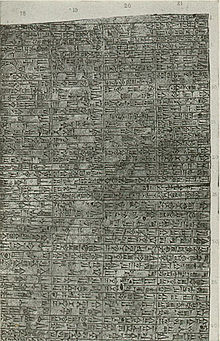Code of Hammurabi
The Code of Hammurabi was a legal code of Babylonia written about 1700 BC.

It was written on a stele (a large stone monument), and put in a public place where everyone could see it. The stele was later captured by the Elamites and taken to their capital, Susa. It was found there again in 1901, and is now in the Louvre Museum in Paris.
The code of Hammurabi had 282 laws written by scribes on 12 tablets.[1] Unlike earlier laws, it was written in Akkadian, the daily language of Babylonia.

The Code of Hammurabi is the longest-surviving text from the Old Babylonian period.[2] The code is an early example of a law regulating a government: a kind of primitive constitution.[3][4] The code is also one of the earliest examples of the "presumption of innocence" (innocent until proven otherwise). It suggests that both the accused and accuser have the opportunity to provide evidence.[5]
History change
The Code of Hammurabi was one of several sets of laws in the ancient Near East.[6] The code of laws was arranged in groups, so that everyone who read the laws would know what was required of them.[7] There were earlier laws, and later laws such as the Law of Moses in the Hebrew Bible.[8] These codes come from cultures in a relatively small geographical area, and they have passages which resemble each other.[8]
The content change
Nearly half the Code deals with contracts. It sets the wages to be paid to an ox driver or a surgeon. Other passages set the liability of a builder for a house that collapses, for example, or property that is damaged while left in the care of another.
A third of the code concerns household and family matters such as inheritance, divorce, paternity and sexual behaviour.
An eye for an eye change
For each crime, a specific punishment is listed. Many of them look harsh to people now. The punishments included death, cutting off a body part, and the use of "an eye for an eye, a tooth for a tooth" ideas. The penalties of Hammurabi's laws may seem cruel to modern readers, but the fact that he put into writing the laws of his kingdom is considered an important step forward in the growth of civilization.
The Code of Hammurabi was one of many sets of laws in the Ancient Near East.
Examples change
- If any one steal the property of a temple or of the court, he shall be put to death, and also the one who receives the stolen thing from him shall be put to death. (6)
- If a man takes a woman to marry, but have no sexual intercourse with her, this woman is no wife to him. (128)
- If a son strike[s] his father, his hands shall be cut off. (195)
- If a man put out the eye of another man, his eye shall be put out. (196)
- If he break another man's bone, his bone shall be broken. (197)
- If he put out the eye of a freed man, or break the bone of a freed man, he shall pay one gold mina. (198)
- If he put out the eye of a man's slave, or break the bone of a man's slave, he shall pay one-half of the slave's value. (199)
- If a man knock out the teeth of his equal, his teeth shall be knocked out. (200)
References change
- ↑ "Hammurabi's Code". Think Quest. Archived from the original on 21 November 2009. Retrieved 16 November 2014.
- ↑ "The Code of Hammurabi". The History Guide. 3 August 2009. Retrieved 2 November 2011.
- ↑ William David Thomas, Gareth Stevens (2008). What is a constitution?. Gareth Stevens Pub. p. 8. ISBN 9780836888638.
- ↑ Flach, Jacques (1907). "Le Code de Hammourabi et la constitution originaire de la propriete dans l'ancienne Chaldee". Revue historique. 94 (8). Paris: 272–289.
- ↑ Burgess A.W.; et al. (2009). Victimology: theories and applications. Jones & Bartlett Learning. p. 103.
- ↑ "The Code of Hammurabi: translated by L. W. King". Yale University. 2005. Archived from the original on 16 September 2007. Retrieved 14 September 2007.
- ↑ "The Code of Hammurabi: Introduction". Ancient History Sourcebook. March 1998. Archived from the original on 29 October 2011. Retrieved 2 November 2011.
- ↑ 8.0 8.1 Barton G.A (1916). Archaeology and the Bible. University of Michigan Library. p. 406.
Other websites change
- Clear and detailed images and description in French from the Louvre Museum